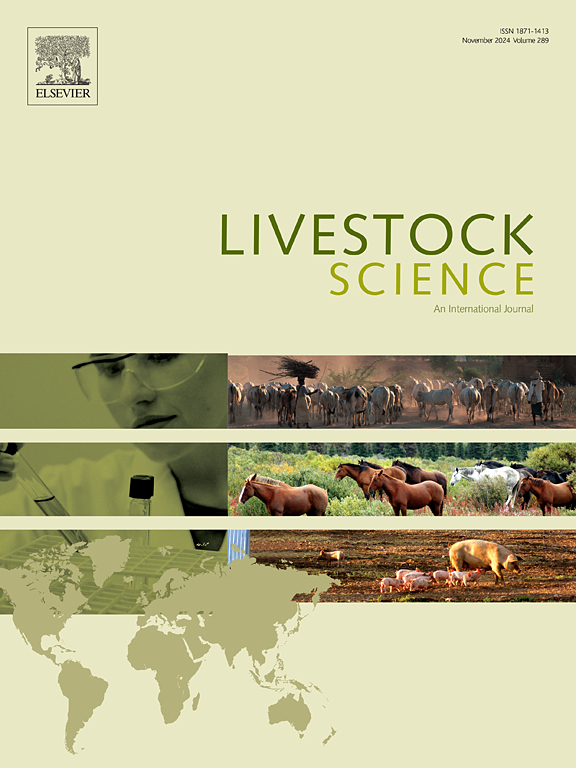Enhancing growth performance and health of coloured-broiler chickens with signal grass meal (Brachiaria decumbens) supplementation under tropical conditions
IF 1.8
3区 农林科学
Q2 AGRICULTURE, DAIRY & ANIMAL SCIENCE
引用次数: 0
Abstract
This study examines the impact of signal grass (Brachiaria decumbens) as a phytobiotic supplement on the production performance and health of coloured-broiler chickens reared in tropical environments. A total of 216 day-old Sasso broiler chicks were randomly assigned to six treatment groups with six replications each. All six treatments received the same commercial diets with some adjustments: Treatment 1 (negative control) with only commercial feed, Treatment 2 (positive control) with 100 mg kg-1g kg-1 oxytetracycline, Treatment 3, 4, 5, and 6 with 1.25, 2.50, 3.75, and 5.00 g kg-1 of B. decumbens grass meal, respectively, without antibiotic. Throughout the eight-week study, body weight and feed intake were recorded weekly for each replicate to calculate body weight gain and feed conversion ratio. Additional evaluations included nutrient digestibility, gut histomorphology, cecal microflora population, carcass characteristics, and meat quality. Blood biomarkers and biochemistry were also analysed to evaluate the chickens' health status. Results indicated that broilers supplemented with B. decumbens grass meal, particularly T6 showed significantly (p<0.05) superior growth performance compared to the negative with reduced FCR of 6.8%. Apparent ileal digestibility was also significantly improved in T6, with 22.32% higher CP digestibility. Enhanced gut histomorphology and a healthier cecal microbial population supported improved nutrient absorption and overall gut health, as evidenced by significant increases in the villi-to-crypt ratio and a higher coliform count than the control. Enhanced carcass characteristics, such as higher full gizzard and gastrointestinal tract weights of T6 broilers, further supported improved digestibility. The supplementation also improved meat quality, with blood biomarkers indicating lower stress and inflammation levels comparable to T2. Additionally, the blood biochemistry of T6 broilers suggested hepatoprotective and hypocholesterolemic effects. Therefore, broilers in T6 demonstrated that B. decumbens has significant potential as an effective feed additive to replace antibiotics in the tropical poultry sector due to its phytocompounds profile, including high saponin content.
在热带条件下补充信号草粉(十日草),提高彩色肉鸡的生长性能和健康水平
本研究探讨了信号草作为植物生物补充剂对热带环境下饲养的彩色肉鸡生产性能和健康的影响。总共 216 只日龄萨索肉鸡被随机分配到六个处理组,每组六个重复。所有六个处理组都使用相同的商品日粮,但做了一些调整:处理 1(阴性对照)仅使用商品饲料,处理 2(阳性对照)使用 100 mg kg-1g kg-1 的土霉素,处理 3、4、5 和 6 分别使用 1.25、2.50、3.75 和 5.00 g kg-1 的十日红草粉,不使用抗生素。在为期八周的研究中,每周记录每个重复的体重和采食量,以计算体重增加和饲料转化率。其他评估包括营养物质消化率、肠道组织形态学、盲肠微生物菌群、胴体特征和肉质。此外,还分析了血液生物标志物和生化指标,以评估鸡的健康状况。结果表明,与阴性饲料相比,添加十日青草粉(尤其是 T6)的肉鸡生长性能明显优于阴性饲料(p<0.05),FCR 降低了 6.8%。T6的回肠消化率也明显提高,CP消化率提高了22.32%。与对照组相比,T6 的肠道组织形态学得到改善,盲肠微生物种群更健康,这有助于提高营养吸收和整体肠道健康水平,这体现在绒毛与盲肠的比率显著提高,大肠菌群数量增加。胴体特征的改善,如 T6 肉鸡全肫和胃肠道重量的增加,进一步支持了消化率的提高。补充剂还能改善肉质,其血液生物标志物表明应激和炎症水平低于 T2。此外,T6 肉鸡的血液生化指标表明其具有保护肝脏和降低胆固醇的作用。因此,T6 的肉鸡表明,由于其植物化合物特征(包括高皂苷含量),十日咳蚕豆具有作为热带家禽业有效饲料添加剂替代抗生素的巨大潜力。
本文章由计算机程序翻译,如有差异,请以英文原文为准。
求助全文
约1分钟内获得全文
求助全文
来源期刊

Livestock Science
农林科学-奶制品与动物科学
CiteScore
4.30
自引率
5.60%
发文量
237
审稿时长
3 months
期刊介绍:
Livestock Science promotes the sound development of the livestock sector by publishing original, peer-reviewed research and review articles covering all aspects of this broad field. The journal welcomes submissions on the avant-garde areas of animal genetics, breeding, growth, reproduction, nutrition, physiology, and behaviour in addition to genetic resources, welfare, ethics, health, management and production systems. The high-quality content of this journal reflects the truly international nature of this broad area of research.
 求助内容:
求助内容: 应助结果提醒方式:
应助结果提醒方式:


